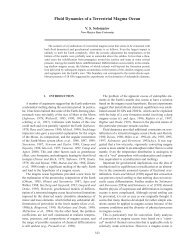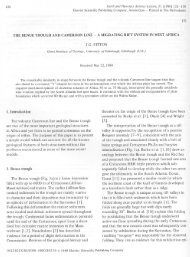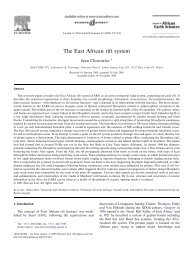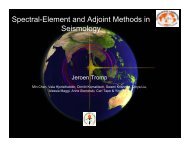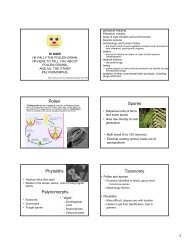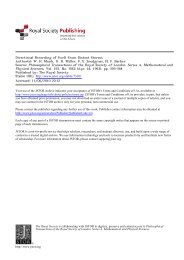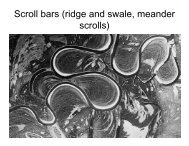High-Resolution Frequency-Wavenumber Spectrum Analysis
High-Resolution Frequency-Wavenumber Spectrum Analysis
High-Resolution Frequency-Wavenumber Spectrum Analysis
- No tags were found...
Create successful ePaper yourself
Turn your PDF publications into a flip-book with our unique Google optimized e-Paper software.
1410 PROCEEDINGS OF THE IEEE, AUGUST 1969where ~W,(X)(’ is the Bartlett windowand lB(k)I’ is the beamforming array response patternl KB(k) = - 1 ‘=j. (15)K j =1Thus, E{P(I., k,)) is obtained by means of a frequencywavenumberwindow IW,(x-R)I2. IB(k-k,)l’. Hence,. Pwill be an. asymptotmdly unbiased estimate for cP ifI WN(x - 1) .B(k- kO)l’ approaches a delta function in .sucha way thatUsing the results of [3] we can compute the variance of Pas, assuming {PIj,} is a multidimensional Gaussian process,Thus,1VAR {P(i,k,)} =- {E[P(A,ko)]}2MP(x, k)B*(k - k,)B(k + E,)dxI W,(X - A)/’ - dk,dk,2n1VAR {P(A, k,)} 2 -{E[p(Eb, ko)]}2, lkol # 0ML= -{E[P(;., k,)])’, lkol = 0.M(16)Since the variance of P approaches zero as M approachesinfinity, it follows that P is a consistent estimate for cP.We follow Blackman n d Tukey [4] and assume thatP(I., k,) is a multiple of a chi-square variable so that toestablish confidence intervals the chi-square distributioncan be used with the number of degrees of freedom k given byk = 2{E[P(E., k,)])’/VAR [&, k,)]= 2” lkol # 0 (17)= M, lkol = 0,if M = 36, k = 72, and the 90 percent confidence limits areapproximately _+ 1.2 dB, and if lk,l ZO. When lkol =0, theselimits are approximately 1.6 dB.HIGH-RESOLUTION METHOD FOR ESTIMATINGFREQUENCY-WAVENUMBER SPECTRUMThe high-resolution estimate for P(2, k) is defined asC‘P’(1, k) = gjl(i) exp [ik .(xj- xl)],I = 1 ]-I (18)where {gjl(I.)} is the inverse of the spectral matrix {&I.)}.The motivation for this procedure can be given by writing(18) asKP‘(E,, k) = 1 Aj*(/,, k)A,(I., k)A,(I.) exp [ik .(xj- x/)]wherej,l= 11 M I KM n=lA;(& k)S,(I.) exp [ikand {qij(J., k)} is the inverse of the matrix (exp [ik .(xj-xl)]$,(I.)}. Thus, P‘(;., k,) is the power output of an arrayprocessor, known as a maximum-likelihood filter, whosedesign is determined by the sensor data and is different foreach wavenumber k,, which passes undistorted any monochromaticplane wave traveling at a velocity correspondingto the wavenumber ko and suppresses in an optimum leastsquaressense the power of those waves traveling at velocitiescorresponding to wavenumbers other than k,, cf. [3, (122)and (123)l. It should be noted that the amount of computationrequired to obtain P’ is almost the same as that to getp, since only an additional Hermitian matrix inversion isrequired.We now wish to compute the mean and varidP’.In order to do this we assume that M, N are large enough sothat as an approximation we may replace &(Eb) by &(A)in the definition for Aj(,i, k) in (20). This then implies thatthe weights A,()., k) are not random and can be replaced bytheir expected values. This is a simplifying assumption,which is not actually valid, since these weights are designedfrom the data. However, it does appear to be a reasonableapproximation. Using this assumption we havewhereE{P’(i, k,)) = j:zjIm J:mp(x, k)l WN(x - j-1(211KB’(j-, k, ko) = A,@, k,) exp [i(k- k,) . xi]. (22)j= 1It should be noted that the functional form, or shape, of B’changes as a function of the wavenumber k,. Thus,E(P‘(1, k,)} is obtained by means of a frequency-wavenumber.windowIWN(x-j.). B’(j., k, k,)(’. Hence, P‘ will bean asymptotically unbiased estimate for cP if IW,(x- 2)* B’(Iv, k, k,)/’ approaches a 3-dimensional delta functionin such a way thatwhere c is some positive number.Authorized licensed use limited to: WASHINGTON UNIVERSITY LIBRARIES. Downloaded on June 22,2010 at 13:34:08 UTC from IEEE Xplore. Restrictions apply.




